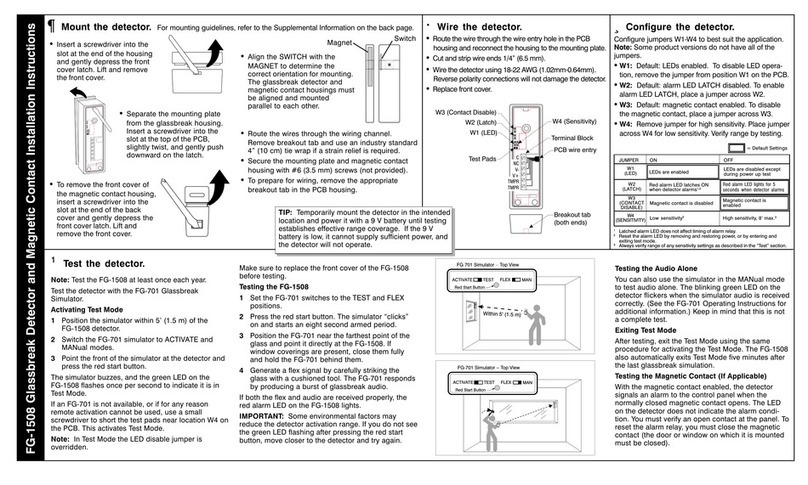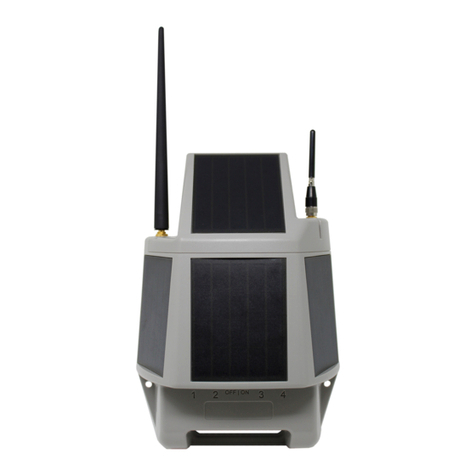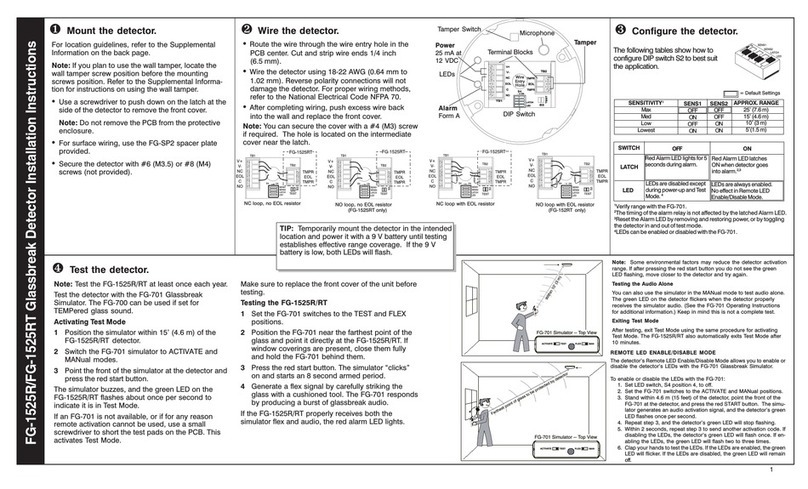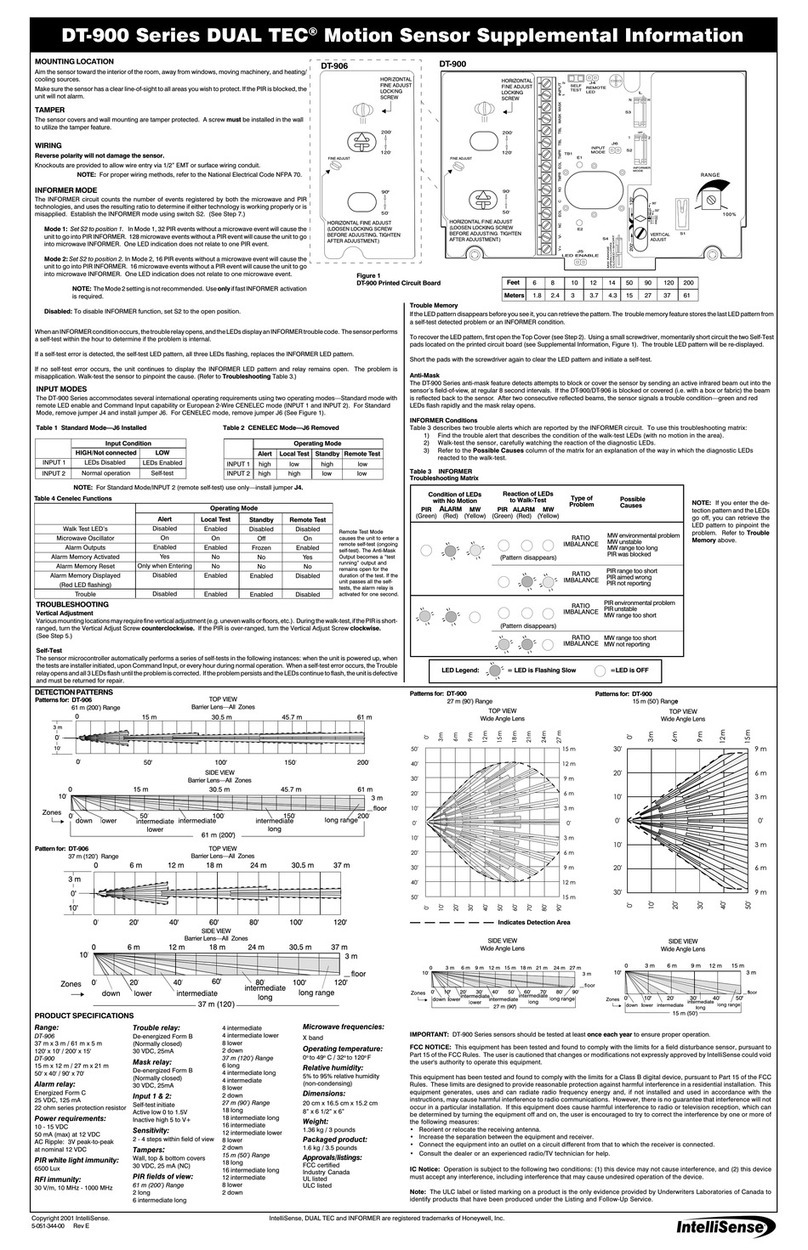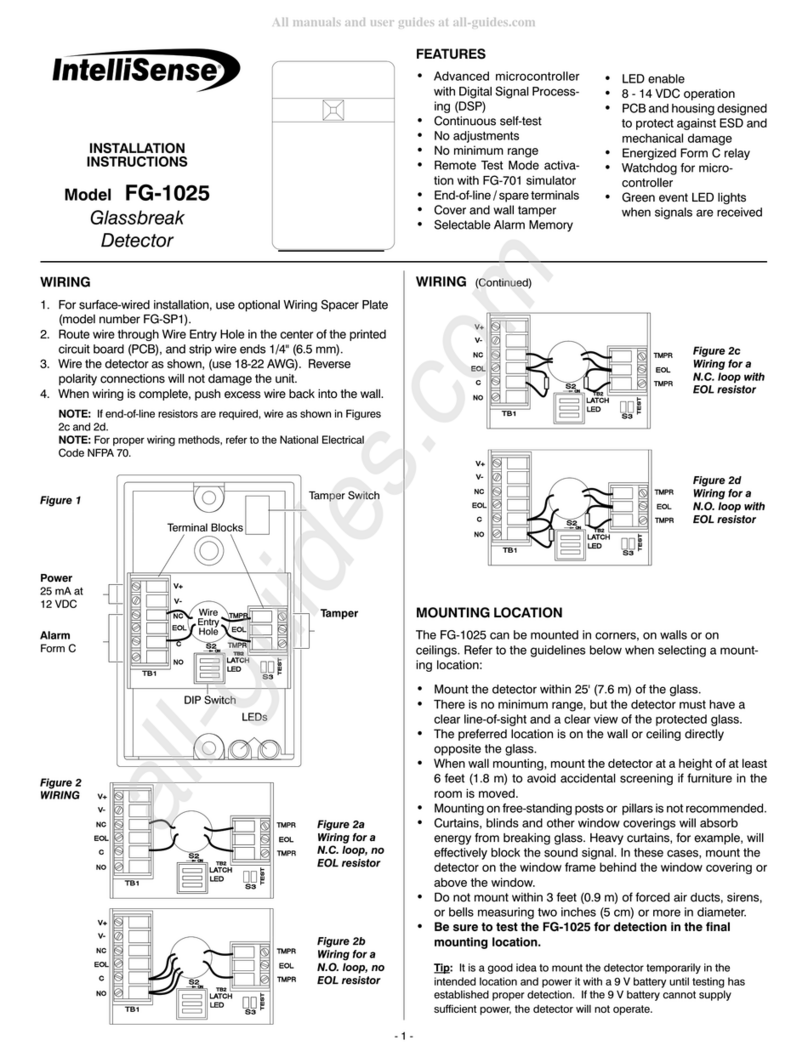
Refer to Installation Instructions and diagrams (next page) when installing this product
©2003 IntelliSense. All rights reserved.
FlexGuard is a registered trademark of Honeywell International,
Inc. - All other brands mentioned are the trademarks or
registered trademarks of their respective owners. Specifications
subject to change without prior notice.
Ê5-051-740-00AwŠ
5-051-740-00A
FlexGuar
®FG-1625SN-ADT SIM Glassbreak Detector Su
lemental
1. General Information
The FG-1625SN-ADT glassbreak detector senses the
sound of breaking plate, tempered, laminated, wired,
coated, and sealed insulating glass. This device is
designed for use only with controls supporting SIM
(polling loop) technology.
Control units for use in Canada utilizing polling loops
require compatibility analysis by Underwriters'
Laboratories of Canada for glass break detectors that
are intended to be connected to these control units.
Refer to the Installation Instructions for the control unit
before installing burglar alarm equipment.
NOTE: The FG-1625SN-ADT does NOT illuminate its LEDs on
power-up. LEDs operate only in Test Mode.
2. Choosing Mounting Location
The preferred mounting location for the device is on a
wall or ceiling, opposite the protected glass.
For the best detector performance, select a mounting
location that is:
• within 7.6 m (25 feet) of the protected glass;
• within clear view of the protected glass;
• at least 2 m (6.5 feet) from the floor;
• at least 1 m (3.3 feet) from forced air ducts;
• at least 1 m (3.3 feet) from sirens or bells greater
than 5 cm (2 inches) in diameter.
• between the protected glass and any heavy
window coverings that may be present.
Alternatively, when heavy window coverings are
present, the detector can be mounted on the frame
of the window.
Avoid mounting the detector on the same wall as the
protected glass, on free-standing posts or pillars, or in
rooms with noisy equipment (air compressors, bells,
power tools, etc.), if this equipment is operated when
the detector is armed.
3. Testing Mounting Location
You can test the detector in the desired mounting
location before drilling/wiring by connecting a 9V battery
to the polling loop terminal block. Observe the polarity
marked on the PC board. After applying power, allow ten
seconds for the unit to stabilize before testing. Follow
the procedure described in “Testing the Detector” (next
column) to confirm proper operation.
A new 9V alkaline battery such as Duracell MN1604 will
power 150-200 setup tests, assuming a test time of 5
minutes. The battery is usable down to a voltage of 6.5V
when connected to the detector. If the battery cannot supply
sufficent power, the detector will not operate. The FG-
1625SN-ADT does NOT indicate low voltage with the LEDs.
Suitable battery connectors include Radio Shack part
numbers 270-324, 270-325, and 910-0351.
4. Configuring Sensitivity (Range)
DIP switches SENS1 and SENS2 set detector
sensitivity (range), as shown:
SENSITIVITY RANGE * SENS1 SENS2
MAX 25 ft (7.6m) OFF OFF
MEDIUM 15 ft (4.6m) ON OFF
LOW 10 ft (3m) OFF ON
LOWEST 5 ft (1.5M) ON ON
*This detector is shipped from the factory with sensitivity set to
minimum. At this setting the effective range in most environ-
ments is approximately five feet. Be sure to test the installation
with the FG-701 Glassbreak Simulator and increase the
sensitivity setting if necessary.
5. Enabling Rear Tamper
The FG-1625SN-ADT is equipped with normally-closed
(NC) cover and wall tamper switches. Each unit is
shipped with the cover tamper operational, and the wall
tamper disabled.
To enable the rear tamper, remove the plastic tab on the
back of the detector, using needle-nose pliers. The wall
tamper arm will extend through the hole.
Proceed with
the mounting instructions to install the wall tamper screw.
6. Mounting the Detector
Note: If ceiling mounted, the end with the hole
(microphone end) should face the glass being protected.
1.
If using optional Wall Tamper:
Mark the
mounting location for the wall tamper screw
based on the final location of the detector.
Then, install the wall tamper screw so that it will
just make contact with the bottom of the tamper
cavity when the unit is mounted.
Use a flat head
M4 or M5 screw (#8 or #10).
2. Position the unit over the wall tamper screw (if
used), then mark the mounting screw and wire
openings.
If required by the location, install wall
anchors for the mounting screws.
3. Secure the unit to the wall or ceiling, oriented
so the microphone has the best line of sight to
the protected glass.
Use M3 (#6) flat or pan
head screws.
NOTE: A screw capture feature designed to make
ceiling mounting easier will cause some resistance when
inserting the screw into the plastic.
7. Wiring the Detector
Refer to the wiring diagram on page 1. Pull the polling
loop wires through the center Wire Entry hole and
connect them to the terminal block, observing the polarity
marked on the PC board. After connecting the polling
loop, allow ten seconds for the unit to stabilize before
testing. NOTE:
Accidental reverse polarity will not harm
the detector or the control.
NOTE: This sensor must be connected to a UL or ULC Listed
power supply or UL or ULC Listed control unit capable of
supplying a minimum of four hours of standby power.
8. Address/Serial Number ID
This detector's unique, factory-assigned serial number
can be found on the bar code label on the PC board (see
figure). The serial number can be entered by one of the
following methods:
1. Downloading (Zone Definition screen of Compass
downloading software). Recommended for large
installations and installations where foot traffic
cannot be controlled.
2. Manually, enter the device’s serial number by
referring to the "Point Programming Section" of
the control panel’s instructions.
IMPORTANT: To enter the serial number, refer to the
control’s programming instructions, noting the
following:
• Input Type = 1 (FI) Fixed (permanent)
To fault the detector when prompted, follow the
instructions under “Testing the Detector”.
9. Testing the Detector
The detector should be tested at least once each year.
Test the detector with the FG-701 (or GBS-7)
Glassbreak Simulator. No other simulators should be
used with the FG-1625SN-ADT. The detector must first
be placed in Test Mode (and you must close the cover.)
NOTE: In Test Mode, the LEDs are enabled and detector
current can be as high as 5 mA. Be sure to exit Test Mode on
completion of testing.
To enter Test Mode manually:
1. Open the front cover.
2. Use a screwdriver to short the Test Mode pads
on the PC board (see diagram on next page).
3. Close and secure the front cover for maximum
simulator detection.
The detector’s green LED blinks approximately once per
second to indicate that it has entered Test Mode.
To enter the Test Mode with the FG-701:
1. Close and secure the front cover for maximum
simulator detection.
2. Stand within 1.5 m (5 feet) of the detector.
3. Switch the FG-701 to ACTIVATE and MANual
modes.
4. Point the front of the glassbreak simulator
towards the detector. Press the red START
button to send a short activation code.
When the detector enters Test Mode, the green LED on
the detector flashes about once per second. If the green
LED does not flash, move closer to the detector and
repeat the procedure.
Close the cover during test!
Testing the Detector (flex and audio signals):
To test the FG-1625SN-ADT:
1. Place the detector in Test Mode.
2. Set the tester switches to the TEST and FLEX
positions.
3. Position the tester near the farthest point of the
protected glass, and point it directly at the
detector. If window coverings are present, close
them fully and hold the tester between the
coverings and the protected glass.
4. Press the red START button. The simulator
clicks on and starts an 8-second armed period.
5. Generate a flex signal by carefully striking the
glass with a cushioned tool. The tester responds
with a burst of glassbreak audio.
If the detector receives both the flex and audio signals
properly, its red Alarm LED lights for five seconds.
Testing the Detector (audio signals only):
The FG-701 can also be used to test the detector’s
ability to receive audio signals only. In Test Mode,
when the detector receives the audio signal from the
simulator, the green Event LED flickers.
Exiting Test Mode:
Test mode will automatically time out after five minutes.
If you need to exit Test Mode sooner, exit by following
the same procedure used to enter Test Mode.
10. LED Indicators
The detector is equipped with two LEDs: a green Event
LED and a red Alarm LED. Both LEDs are normally
disabled, but they are automatically enabled in Test
Mode. The following table summarizes the LED
messages in Test Mode.
CONDITION GREEN LED RED LED
Test Mode Flash once per sec OFF
Test Mode, event detected Flicker OFF
Test Mode, alarm Flash once per sec ON 5 seconds
11. Cover Screw
The front cover can be secured after installation. To do
so, pierce the cover breakout flash and secure the front
cover with a ¼-in., #4 (2.2mm) screw.
12. Nominal Glass Thickness Chart
Nominal Thickness
Glass Type* Minimum Maximum
Plate 3a 2mm (3/32 in.) 10mm (3/8 in.)
Tempered 3mm (1/8 in.) 10mm (3/8 in.)
Laminated13mm (1/8 in.) 14mm (9/16 in.)
Wired 6mm (1/4 in.) 6mm (1/4 in.)
Coated 2,3b 3mm (1/8 in.) 6mm (1/4 in.)
Sealed
Insulating1,3b, 4
3mm (1/8 in.)
[13mm (1/2 in.)
overall]
6mm (1/4 in.)
[19mm (3/4 in.)
overall]
* Minimum size for all types is 28cm (11 in.) square; glass must be
framed in the wall or mounted in a barrier at least 0.9m (36 in.) wide.
1 Protected only if both plates in the unit are broken
2 Coated glass with security films up to 0.3mm (12 mils) thick (including
films for solar protection) may be used. Film Technologies
International, Inc.’s GLASS-GARD GGLL 1200 has been evaluated
with this product by Underwriters Laboratories, Inc. at the
manufacturer’s request.
3 In compliance with Underwriters Laboratories of Canada’s Standard
for Intrusion Detection Units (CAN/ULC-S306-M89):
a. Plate glass 3mm (1/8 in.) to 10mm (3/8 in.) can be protected.
b. ULC recognizes a maximum range for protecting sealed insulating
glass and coated glass of 3.8 m (12.5 ft).
4 UL recognizes a maximum range for protecting sealed insulating glass
of 6.1m (20 ft.) with sensitivity set at maximum.
13. Specifications
Range:
7.6 m (25 ft.) maximum,
omni directional
No minimum range
Operating
Temperature:
-10° to 50° C (14° to
122° F)
Storage: -20° to 50° C
(-4° to 122° F)
Tamper Switch:
Combination cover/ wall
tamper
RFI Immunity:
10 V/m,
10 MHz – 1000 MHz
ESD Immunity:
10 kV discharges of
either polarity to exposed
surfaces
Power Requirements:
Input Voltage:
7 – 16 V peak-to-peak
at the polling loop
terminals
Current:
1 mA max, w/ LEDs
disabled
5 mA max, w/ LEDs
enabled
Dimensions:
115 mm x 72 mm x 27
mm
(4.5 in. H x 2.8 in. W x
1.05 in. D)
Weight:
98 g (3.5 oz.)
Packaged Product: 126
g (4.5 oz.)
Approvals / Listings:
FCC and IC verified,
UL listed, ULC listed,
CE, C-Tick
NOTICES
FCC Notice: This equipment has been tested and found to comply with
the limits for a Class B digital device, pursuant to part 15 of the FCC
Rules. These limits are designed to provide reasonable protection
against harmful interference in a residential installation. This
equipment generates, uses, and can radiate radio frequency energy
and, if not installed and used in accordance with the instructions, may
cause harmful interference to radio communications. However, there
is no guarantee that interference will not occur in a particular
installation. If this equipment does cause harmful interference to radio
or television reception, which can be determined by turning the
equipment off and on, the user is encouraged to try to correct the
interference by one or more of the following measures: 1) Reorient or
relocate the receiving antenna, 2) Increase the separation between the
equipment and receiver, 3) Connect the equipment into an outlet on a
circuit different from that to which the receiver is connected. The
installer can also consult an experienced radio/television technician for
additional suggestions, if necessary.
IC Notice: This Class B digital apparatus meets all requirements of the
Canadian Interference-Causing Equipment Regulations.
Cet appareil numérique de la Classe B respecte toutes les exigences
du Règlement sur le matériel brouilleur du Canada.
